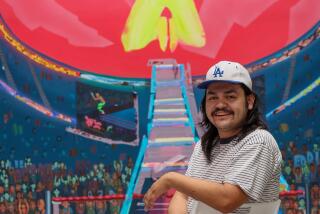ART REVIEW : BOB & BOB: TWO ROBERTS’ MISRULES OF DISORDER
Bob & Bob (a.k.a. Paul Velick, or Light Bob, and Francis Shishim, the Dark Bob), Los Angeles’ irreverent multimedia duo, have been “making art that makes sense” since 1975. Taking on the personae of a pair of bewildered, somewhat naive but ultimately sincere art careerists, Bob & Bob set out to restore art to the ordinary American, and hopefully get rich in the process.
This indefinable fusion of Fluxus, Gilbert & George and Andy Warhol encompasses every imaginable medium--paintings, drawings, sculptures, dioramas, videos, performance, improvised happenings, recordings and installations--a satirical assault on contemporary culture that quickly became its own self-fulfilling prophecy.
More than 10 years later, the Bobs celebrate their collective longevity with “Bob & Bob: A Retroselective, 1975-1986” at Otis/Parsons’ Exhibition Center (through Saturday). This exhaustive overview not only places the team within the overall aesthetic and political context of the last decade (and finds them alarmingly ahead of their time in many areas) but also successfully chronicles their relationship, both with themselves and the outside world.
On graduating from Art Center, Bob & Bob decided to tackle the Realpolitik of the art world head on by treating it as a business. Donning suits and moving into a Beverly Hills office, they observed their milieu both from within and without, simultaneously appropriating and propagating their supposed target. By living the Beverly Hills life style like a pair of Bohemian goofballs, they were able to point up both its contradictions and its power to seduce. The exhibit documents this era through the Bobs’ cartoonlike drawings and paintings of bankers (highly reminiscent of George Grosz), as well as photographs of street happenings, such as sunbathing on Rodeo Drive (“Rodeo Beach”) and getting thrown out of La Scala for not being able to pay the bill (“Oh Great, Now What?”).
Most of this early activity was accompanied by a self-conscious media hype that rivaled anything dreamed up by Madison Avenue. The Bobs promoted performances and exhibitions by parodying the Beatles (as the Fab Two), David Bowie’s then androgyny and Jimi Hendrix. Bob & Bob literally became the artwork; the packaging was the product. This, of course, predates much of the current aesthetic predilection for appropriation and recycling of advertising imagery, but Bob & Bob accompanied this detached opportunism with a genuine bewilderment about exactly where they, and by extension artists as a whole, fit into the wider scheme of things. They could be, by turns, both passive and aggressive, social and anarchistic, happy-go-lucky and neurotic.
Yet by the 1980s, this pluralistic persona had become increasingly confused and schizophrenic, their attempts at assimilation more desperate. In the very funny video series, “Here’s the News,” for example, the Bobs are seen in their suits, sitting in chairs while communing with nature and the public at large, literally attempting to fit into the world. They appear to blend in perfectly--they bother nobody, nobody bothers them--but whether in the supermarket, at the zoo or in the park, Bob & Bob are conspicuous by the very self-consciousness of their attempts to conform.
Although Bob & Bob are now a bicoastal collaboration (Light Bob moved to New York in 1982) and their partnership has taken on an increasingly conceptual vein (i.e., the idea of collaboration as an artistic ethos), the exhibition is reassuring evidence that the two haven’t lost their knack for self-promotion and commercial hype. Paraphernalia and documentation from past events--posters, sports jackets, suits--are proudly displayed (with accompanying price tags) so that artifacts metamorphose into artworks and costumes become cultural icons (like Elvis Presley’s socks). The old self-fulfilling prophecy recycles itself once more as its own, updated special event. Ultimately the strength (and perhaps the weakness) of Bob & Bob’s persona is that it’s impossible to critique. It is what it is, a parody of what it is, and a cynical attempt to cash in on itself. Which in itself has to be a pastiche. Right, guys?
More to Read
The biggest entertainment stories
Get our big stories about Hollywood, film, television, music, arts, culture and more right in your inbox as soon as they publish.
You may occasionally receive promotional content from the Los Angeles Times.










